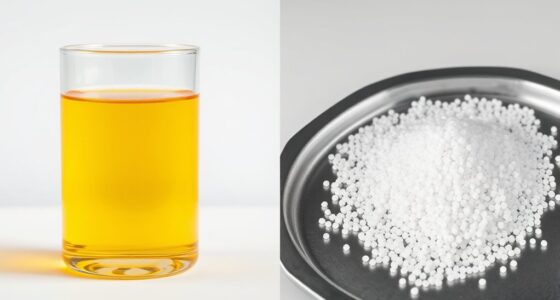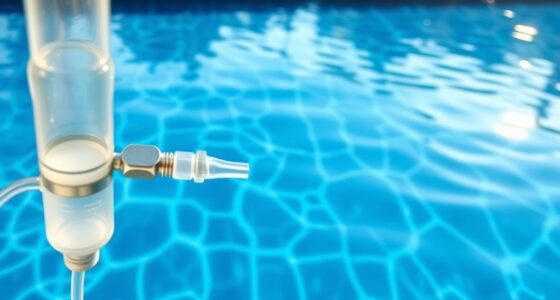If you’re facing high calcium hardness and scale issues, start by testing your water to pinpoint calcium levels and identify signs like white deposits on fixtures or cloudy water. Investigate your water source—natural mineral content or environmental factors often contribute. To prevent buildup, consider installing water softeners or employing pH adjustments, and regularly maintain your system. Learning about effective treatment options helps you manage scale better and ensure ongoing water quality improvements.
Key Takeaways
- Test water mineral content regularly to identify elevated calcium levels and assess scale risk.
- Use water softeners or ion exchange systems to reduce calcium hardness effectively.
- Maintain proper pH levels to prevent mineral precipitation and scale formation.
- Clean and flush appliances periodically to remove existing mineral deposits and prevent buildup.
- Install filtration or sequestrants to bind calcium ions before they cause scaling issues.
Understanding Calcium Hardness and Its Impact on Water Systems
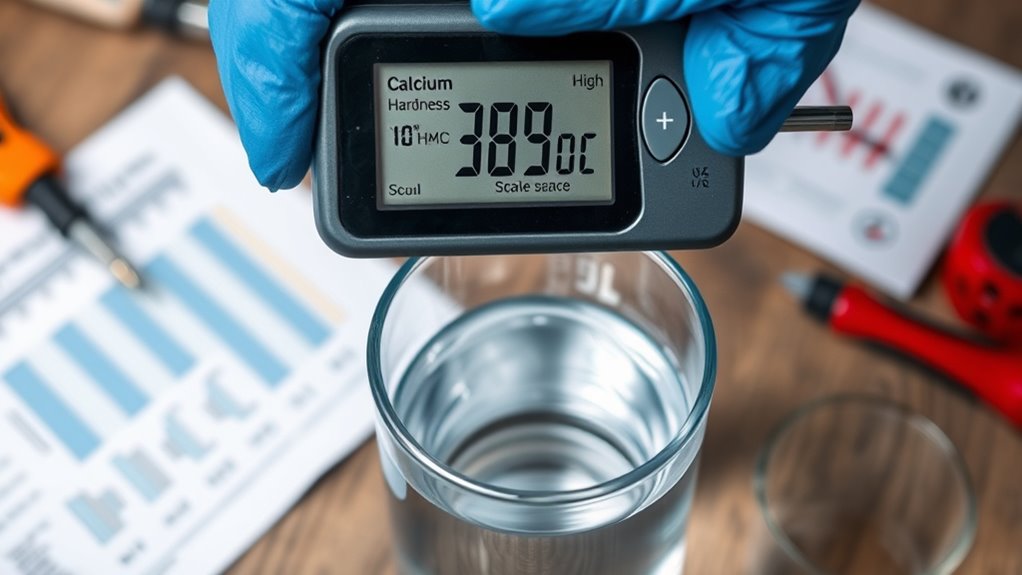
Calcium hardness refers to the amount of dissolved calcium minerals in your water, which can considerably affect your water system’s performance. Understanding calcium chemistry is essential because it influences how minerals interact with your plumbing and appliances. Water mineralization, driven by calcium levels, can lead to scale buildup, reducing efficiency and lifespan of equipment. When calcium dissolves into water, it changes the water’s hardness, making it more difficult to find effective solutions for maintenance. High calcium levels can cause mineral deposits that impact heat transfer and flow rates, increasing energy costs and risking damage. By recognizing how calcium chemistry affects water mineralization, you can better predict potential issues and take proactive steps to manage water quality, ensuring your system runs smoothly and efficiently. Additionally, awareness of calcium hardness helps in selecting appropriate water treatment methods to prevent scale formation and protect your appliances. Understanding how water chemistry interacts with your system allows for more targeted and effective maintenance strategies. Recognizing the scale formation process is key to implementing preventive measures that extend the lifespan of your equipment. Moreover, understanding mineral interactions can aid in choosing the right treatments to mitigate scale issues effectively. To further support these efforts, monitoring water quality parameters regularly can help detect early signs of mineral buildup before significant damage occurs.
Identifying Signs of Scale Buildup and Hard Water Issues

You might notice white mineral deposits on fixtures or around drains, which indicate scale buildup. Additionally, water clarity can change, appearing cloudy or murky over time. Recognizing these signs helps you catch hard water issues early before they cause more damage. Implementing effective water treatment solutions can help mitigate scale formation and improve water quality. Regular testing of water hardness levels can further assist in maintaining optimal water conditions and preventing excessive calcium buildup. Staying informed about water hardness and its effects can also help you take proactive steps to protect your plumbing and appliances from damage. Using water softeners can be an effective method to reduce calcium and magnesium concentrations, thereby minimizing scale buildup.
Visible Mineral Deposits
How can you tell if mineral deposits are affecting your water system? Look for visible signs like white, chalky spots on fixtures, faucets, or around drains. You might notice a crusty film or a cloudy film on glassware and sinks. These are clear indicators of mineral buildup caused by hard water. If you see these deposits, scale prevention becomes essential to avoid further damage. Regularly inspecting your appliances and plumbing can help catch buildup early. Scaling can impair efficiency and lead to costly repairs. Maintaining proper water chemistry and using water softeners can reduce mineral deposits. Spotting these deposits early allows you to take action before scale causes serious issues. Addressing visible mineral deposits promptly keeps your water system running smoothly and extends its lifespan. Additionally, understanding the heaviness of pinball machines can help in safely handling and relocating appliances affected by mineral buildup. Knowing the effects of mineral scale can also guide you in choosing the right maintenance strategies to prevent long-term damage.
Water Clarity Changes
Visible mineral deposits are often the first sign of hard water problems, but changes in water clarity can reveal scale buildup that isn’t immediately visible. If your water looks cloudy or has a film, it indicates mineral buildup affecting clarity. Poor pH balance can contribute to scale formation, as high calcium levels disrupt the water’s natural acidity. You might notice haziness or streaks in the water, signaling ineffective mineral filtration. Regularly testing your water’s clarity helps catch issues early. Improving mineral filtration systems can reduce mineral concentration, restoring better water clarity. Also, adjusting the pH balance ensures minerals stay dissolved, preventing scale buildup. Water quality and keeping an eye on water clarity provides a quick, visual way to identify underlying hard water issues before they cause more significant problems. Incorporating lifestyle habits that reduce mineral exposure can further help maintain water quality and prevent scale formation. Additionally, understanding the vulnerabilities of AI models can guide you in selecting more reliable water treatment methods. Being aware of material durability is crucial, as some materials may degrade faster under high mineral content conditions.
Testing and Analyzing Water Quality for Calcium Levels
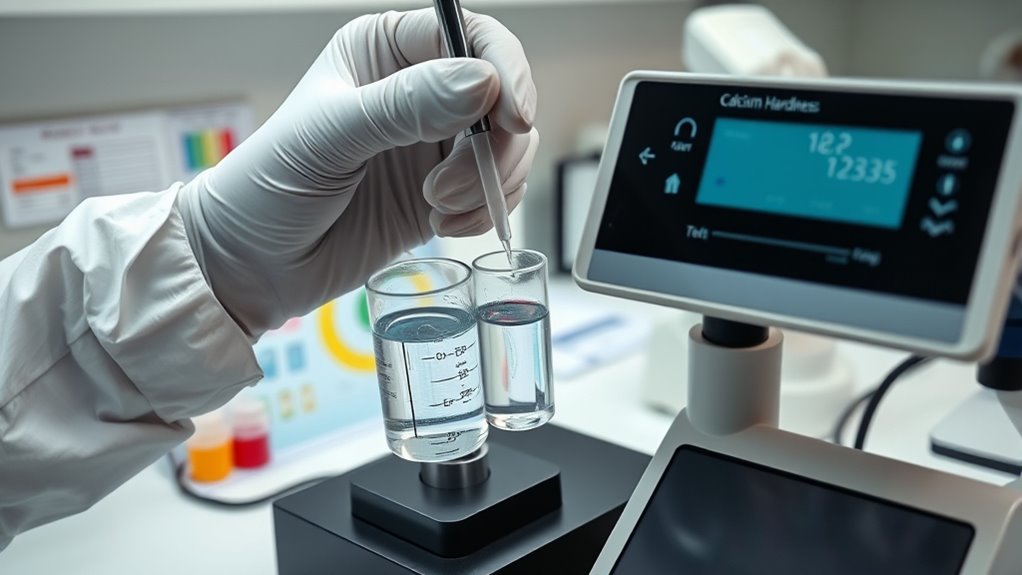
To accurately assess calcium levels in your water, testing and analyzing water quality is vital. Begin with water testing using reliable kits or lab services to measure calcium concentration precisely. Calcium analysis involves checking the hardness levels, usually expressed in parts per million (ppm) or grains per gallon (gpg). Proper testing ensures you identify whether your water’s calcium hardness is elevated. Follow the instructions carefully to obtain accurate results, and consider testing multiple samples over time for consistency. Once you have your data, analyze the calcium levels to determine if they exceed recommended thresholds. This information is essential for deciding on appropriate treatment options or troubleshooting steps. Accurate water testing and calcium analysis form the foundation for effective management of high calcium hardness issues. Additionally, understanding water quality testing methods can help you choose the most suitable approach for your situation.
Common Causes of Elevated Calcium Hardness

Elevated calcium hardness often results from natural mineral content in the source water, especially in areas with limestone, chalk, or gypsum formations. This mineral diversity means calcium ions are abundant, contributing to hardness. pH fluctuation can also cause calcium levels to rise, as changes in acidity loosen calcium from mineral deposits. Common causes include:
Elevated calcium hardness stems from natural mineral content in source water, influenced by local geologic formations.
- Contact with limestone or chalk aquifers
- Geologic formations rich in calcium minerals
- Changes in pH affecting mineral solubility
- Seasonal water flow variations exposing minerals
- Increased mineral leaching due to environmental factors
These factors lead to higher calcium concentrations, which can cause scaling. Understanding these natural causes helps you pinpoint why calcium hardness is elevated, setting the stage for effective troubleshooting.
Evaluating Your Water Source and Its Contributions

Evaluating your water source is crucial for understanding the causes of high calcium hardness. Start by testing the mineral content, focusing on calcium and other dissolved minerals. Knowing the mineral levels helps identify whether your water naturally contains high calcium levels or if external factors are influencing it. Also, check the pH balance, as water with a higher pH can lead to more scale formation and harder water. Understanding how your source contributes to mineral content and pH helps determine if adjustments are necessary before treatment. If your water is sourced from wells or municipal supplies, inquire about their water quality reports. This evaluation provides a foundation for developing effective strategies to reduce calcium hardness and prevent scale buildup.
Strategies for Preventing Scale Formation

Understanding your water source’s mineral content and pH levels helps you identify the root causes of high calcium hardness. To prevent scale formation, focus on strategies like corrosion prevention and pH adjustment. These steps reduce mineral buildup and protect your system.
Consider these measures:
- Regularly monitor and adjust pH levels to stay within the most effective range
- Use pH buffers or chemical treatments to maintain stability
- Install corrosion prevention devices to reduce pipe deterioration
- Use water softeners or ion exchange systems to remove calcium ions
- Routinely clean and flush systems to prevent scale buildup
Implementing these strategies helps minimize scale formation, extending equipment life and improving efficiency. Consistent pH management and corrosion prevention are key in maintaining a balanced, scale-free water system.
Effective Methods for Treating High Calcium Hardness

To effectively treat high calcium hardness, you can consider water softening techniques like ion exchange systems or the use of chemical treatments. These methods help reduce calcium levels and prevent scale buildup. Understanding your options allows you to choose the best solution for your specific water conditions.
Water Softening Techniques
When dealing with high calcium hardness, water softening techniques provide effective solutions to reduce mineral levels and protect plumbing and appliances. These methods include pH adjustment, mineral filtration, and ion exchange. pH adjustment helps prevent scale formation by balancing water chemistry, making minerals easier to remove. Mineral filtration uses specialized media to trap calcium ions before they cause buildup. You might also consider softening systems that employ ion exchange resins, which replace calcium with sodium or potassium. Visualize the process with these steps:
- Installing a whole-house water softener
- Using reverse osmosis units for point-of-use treatment
- Incorporating mineral filtration systems
- Adjusting water pH before softening
- Regular maintenance to ensure effectiveness
These techniques work together to mitigate scale, extend appliance lifespan, and improve water quality.
Chemical Treatment Options
Chemical treatment options offer a quick and effective way to reduce high calcium hardness in water. By adjusting pH levels, you can enhance the effectiveness of your treatment process. Chemical oxidizers help break down scale-forming compounds, minimizing buildup. Common chemicals include lime softening agents and sequestrants that bind calcium ions, preventing scale formation. Proper pH adjustment ensures ideal chemical performance, while oxidizers help eliminate organic materials that contribute to scale. Here’s a quick overview:
| Treatment Method | Purpose | Key Consideration |
|---|---|---|
| pH Adjustment | Improves chemical efficiency | Maintain appropriate pH range |
| Chemical Oxidizers | Break down scale precursors | Use safely and follow dosage |
| Sequestrants | Bind calcium ions | Prevent scale buildup |
Choosing the Right Water Softening and Condition Techniques
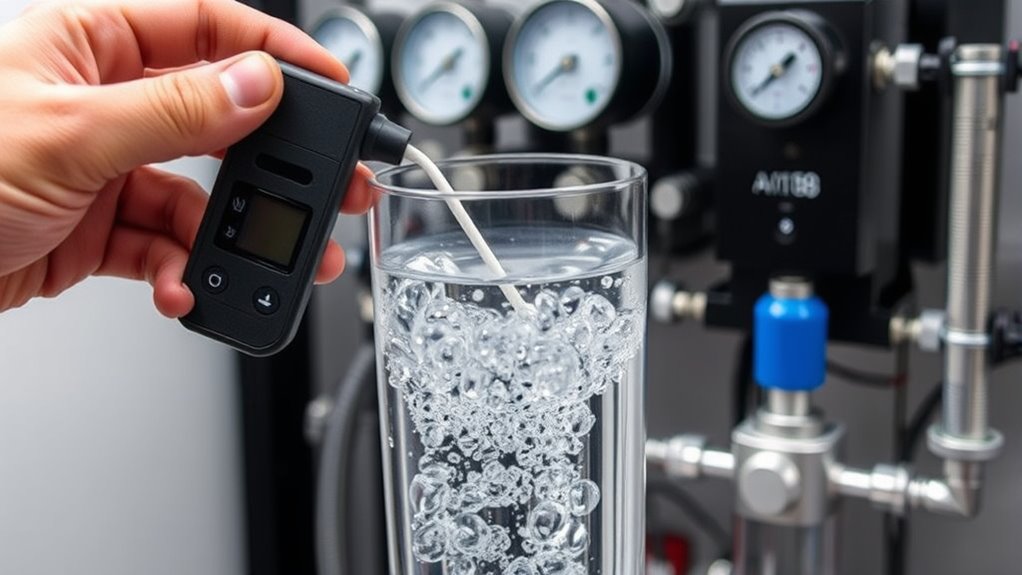
Choosing the right water softening and conditioning techniques is essential for effectively managing high calcium hardness. Your goal is to optimize water mineralization and maintain proper pH balance, preventing scale buildup. Consider options like ion exchange systems that remove calcium ions, or reverse osmosis units for thorough filtration. You might also explore chemical feed systems that adjust water chemistry or specialized conditioners that alter mineral properties without adding chemicals. Visualize your water treatment setup with these aspects in mind:
Selecting proper water treatment methods prevents scale buildup and balances mineral content effectively.
- Ion exchange resins targeting calcium removal
- Reverse osmosis for pure, mineral-reduced water
- pH balancing agents to prevent corrosion or scale
- Water conditioners that modify mineral behavior
- Monitoring tools to ensure ongoing effectiveness
Regular Maintenance and Monitoring for Long-Term Management

Regular maintenance and monitoring are crucial for ensuring your water treatment system continues to effectively control high calcium hardness over time. Regularly check your system’s pH balance to prevent scale buildup and maintain mineral diversity in your water. Consistent testing helps you catch issues early, reducing the risk of damaging scale and ensuring peak performance.
| Task | Frequency |
|---|---|
| pH level testing | Weekly |
| Mineral content analysis | Monthly |
| System inspection and cleaning | Every 3-6 months |
Frequently Asked Questions
How Often Should Calcium Hardness Levels Be Tested in a Water System?
You should test calcium hardness levels regularly, ideally every 1 to 3 months, depending on your water system’s usage and source. Consistent testing frequency guarantees you stay on top of water quality and catch any changes early. Conducting regular water analysis helps identify fluctuations in calcium hardness, allowing you to adjust treatment strategies promptly and prevent scale buildup or other related issues.
What Are the Environmental Impacts of Using Chemical Softening Agents?
Think of chemical softening agents as double-edged swords—you want softened water, but they can cause more harm than good. When you use these chemicals, runoff can carry toxins into nearby waterways, threatening local ecosystems. This runoff increases ecosystem toxicity, harming aquatic life and disrupting habitats. So, while softening water, you’re risking environmental health, making it essential to contemplate eco-friendly alternatives and proper disposal methods to protect the environment.
Can High Calcium Hardness Affect Water Taste or Odor?
High calcium hardness can impact your water taste, making it taste more metallic or bitter. While it doesn’t usually cause strong odor issues, sometimes mineral buildup from high calcium can lead to subtle odor problems. You might notice a chalky or stale smell, especially if scale buildup occurs in your plumbing. Addressing calcium levels can improve both water taste and odor issues, making your water more enjoyable and fresher.
Are There Natural or Eco-Friendly Methods to Reduce Calcium Levels?
Did you know that using eco-friendly methods can considerably reduce calcium levels without harsh chemicals? You can try natural calcium reduction techniques like adding potassium chloride instead of salt or installing a water softener with eco-friendly softening options. These methods are gentle on the environment and your plumbing, effectively lowering calcium hardness. Embracing natural solutions ensures you maintain healthy water quality while protecting the planet.
How Does Seasonal Temperature Variation Influence Scale Formation?
Seasonal temperature changes markedly impact scale formation by affecting thermal expansion and sediment buildup. When water heats up, minerals like calcium precipitate more easily, leading to increased scale deposits. During colder months, reduced thermal expansion slows this process, but sediment can still accumulate. You should monitor your system closely, especially during temperature fluctuations, to prevent excessive scale buildup and maintain efficient operation.
Conclusion
Understanding and managing calcium hardness is essential to prevent costly scale buildup. Did you know that high calcium levels can reduce your water heater’s efficiency by up to 48%? By regularly testing your water and applying the right treatment methods, you can extend your equipment’s lifespan and save money. Stay proactive with maintenance and monitoring, and you’ll keep your water system running smoothly for years to come.


